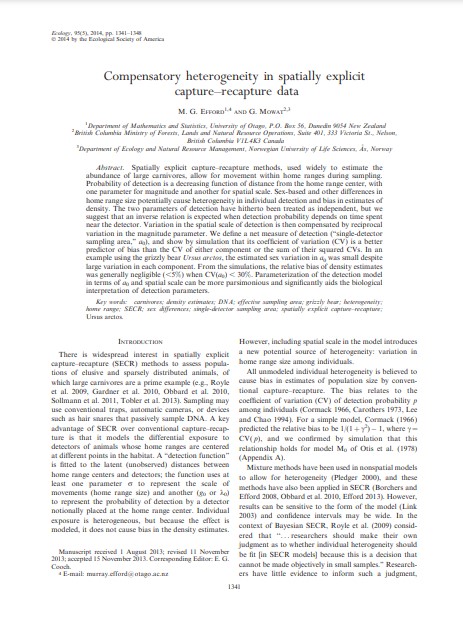Compensatory heterogeneity in spatially explicit capture-recapture data
Bosque Modelo:
Foothills
Temática:
Gestión forestal
Tipo de documento:
Artículo científico
Resumen
Spatially explicit capture–recapture methods, used widely to estimate the
abundance of large carnivores, allow for movement within home ranges during sampling. Probability of detection is a decreasing function of distance from the home range center, with one parameter for magnitude and another for spatial scale. Sex-based and other differences in home range size potentially cause heterogeneity in individual detection and bias in estimates of density. The two parameters of detection have hitherto been treated as independent, but we suggest that an inverse relation is expected when detection probability depends on time spent near the detector. Variation in the spatial scale of detection is then compensated by reciprocal variation in the magnitude parameter. We define a net measure of detection (‘‘single-detector sampling area,’’ a0), and show by simulation that its coefficient of variation (CV) is a better predictor of bias than the CV of either component or the sum of their squared CVs. In an example using the grizzly bear Ursus arctos, the estimated sex variation in a0 was small despite large variation in each component. From the simulations, the relative bias of density estimates was generally negligible (,5%) when CV(a0) , 30%. Parameterization of the detection model in terms of a0 and spatial scale can be more parsimonious and significantly aids the biological interpretation of detection parameters
Información Bibliográfica
Autor:
Efford, M. G.; Mowat, G.
Revista:
ECOLOGY
Año:
2014
N°:
5
País :
Canadá
Páginas:
1341 - 1348
Volumen:
95
Idioma:
Ingles
Palabras claves
carnivores; density estimates; DNA; effective sampling area; grizzly bear; heterogeneity; home range; SECR; sex differences; single-detector sampling area; spatially explicit capture–recapture; Ursus arctos.





